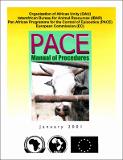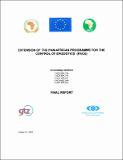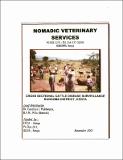Animal Health: Recent submissions
Now showing items 161-180 of 192
-
Proposal for continuation of VSF-Belgium Fight Against Lineage One Rinderpest Virus Project for Southern Sudan, March to October 2004.
The last foci of lineage 1 rinderpest virus in Africa is believed to lie in the southern region of Sudan. The cattle populations in the border areas of southern Sudan move across international borders for pasture and trade. ... -
Technical Assistance to Communication and PrivatisationLegislation.
Rinderpest was first introduced to the African continent in 1841 and it first appeared south of the Sahara in 1884, after infected cane were imported from India. The re salting epidemic killed over 90% of the indigenous ... -
Global plan for PACE Eritrea 1st November 2000 to 31st October 2004.
Eritrea is part of the Horn of Africa and is located on the southern tip of the Red Sea coast of the continent covering an area of 124 432 sq. km. The country consists of arid and semi-arid lands made up of rugged mountains, ... -
Epidemiologist for the Collaborative Centres in Nairobi and N_Djamena.
Rinderpest was first introduced to the African continent in 1841 and it first appeared south of the Sahara in 1884, after infected cattle were imported from India. The resulting epidemic killed over 90% of the indigenous ... -
PACE Kenya project first quarter progress report for year 2 annual work programme.
The second year workplan was approved in December, 2002. Despite the holiday season and national elections, project activities still continued during the quarter. Follow-up investigations of the suspected Laikipia rinderpest ... -
Provision of technical assistance to the national projects of the PACE Final report.
The Regional Technical Assistant, Dr. Nicolas Denormandie, was based at the Regional Coordination Unit of PACE in Bamako (Mali). He was covering initially seven French-speaking countries within Western and Central Africa, ... -
First year annual work programme and cost estimate Twelve (12) Months (2001- 2002).
The Pan-African Rinderpest Campaign (PARC) Kenya project work plan was signed in 1995 and implemented alongside the Emergency Programme for the Eradication of Rinderpest in Kenya (EPERK). The PARC project cost a total of ... -
PACE Manual Procedures.
Animal health is a prior condition for the development of livestock farming and the rural world in Africa where, despite meat imports in particular, the population does not get proper amounts of animal protein. Animal ... -
Extension of the Pan-African programme for the control of epizootics (PACE) Final Report.
The Mid-Term review (MTR) of the PACE programme. conducted in October 2002, concluded that: "...the agreed completion date, October 2004, is no longer realistic and needs to be extended if any results are to be achieved," ... -
Consultancy to assist in the development of a rinderpest eradication strategy in the West and East Nile ecosystems.
Throughout most of the life of the OLS Livestock Programme, conventional wisdom held that rinderpest eradication from southern Sudan was not possible without peace. It was not until 1998, that the extent of the impact of ... -
Annual work programme _ cost estimate for PACE Tanzania Year 2 (1st November 2002 to 31st October 2003).
This is a second Annual Work Plan and Cost Estimate for the PACE (Tanzania) Component which is part of the Regional Pan-African Programme for the Control of Epizootics (PACE) under the African Union Inter-African Bureau ... -
Pan- African programme for the control of epizootics (PACE) Kenya national project.
The PACE programme has the overall objective of contributing to rural development and poverty alleviation. This will be reached through effective disease control and animal he, care, which will secure the availability of ... -
Work programme _ cost estimate Nigeria national PACE programme for the period 1st May, 2002 to 30th April, 2003 (Year 2).
The Nigerian Pan African Rinderpest Campaign (PARC) project came to being through the preparation and approval of a work programme that was considered and endorsed by the Inter-African Bureau for .nimal Resources of the ... -
Pan- african programme for the control of epizootics (PACE) First year annual work programme and cost estimate.
The Pan-African Rinderpest Campaign (PARC) Kenya project work plan was signed in 1995 and implemented alongside the Emergency Programme for the Eradication of Rinderpest in Kenya (EPERK). The PARC project cost a total of ... -
Cross Sectional Cattle Disease Surveillance Bungoma District, Kenya..PDF
This study was undertaken to identify the major diseases affecting and limiting the health and productivity of indigenous zebu cattle in 3 divisions of Bungoma district, Kenya. The survey established the prevalence rate ... -
Rinderpest Eradication Strategy Workshop for Southern Sudan 1st 2nd August 2001 Nairobi..PDF
The Rinderpest Eradication Strategy Workshop for Southern Sudan 1-2ndAugust 2001 was organised by VSF-Belgium for the Operation Lifeline Sudan (OLS) Southern Sector Livestock Programme under the co-ordination of the Pan ... -
Manual on the preparation of national animal disease emergency preparedness plans..PDF
Animal disease emergencies: their nature and potential consequences Animal disease emergencies may occur when there are unexpected outbreaks of epidemic diseases or other animal health related events which have the ... -
Dossier on application for Rinderpest disease free status..PDF
Nigeria is situated in the South Eastern part of West Africa and is bordered to the West by Benin Republic, North by Niger Republic, East by Cameroon, North East by Chad Republic and to the South by the Atlantic Ocean. ... -
An Assessment tie economic Viability of Private Animal Health Service Delivery in Pastoral Areas of-Kenya--.pdf
Livestock keeping is an essential component of the economic well-being of people in sub-Saharan Africa. It provides food, manure, traction, hides and skins, wool and economic security and also contributes to the cultural ... -
Address by Dr. W.N. Masiga, Director OAU-IBAR On The Occasion Of the 24th Meeting of the International Scientific Council for Trypanosomiasis Research and Control
ADDRESS BY DR. W.N. MASIGA, DIRECTOR OAU-IBAR ON THE OCCASION OF THE 24TH MEETING OF THE INTERNATIONAL SCIENTIFIC COUNCIL FOR TRYPANOSOMIAS1S RESEARCH AND CONTROL



















